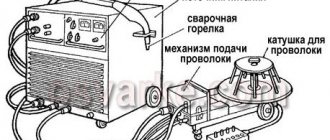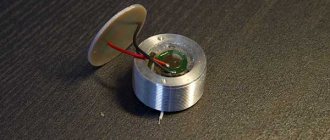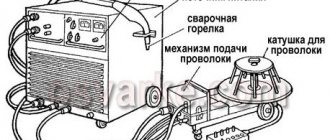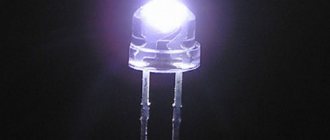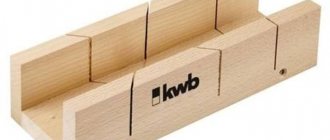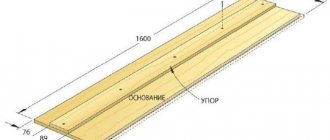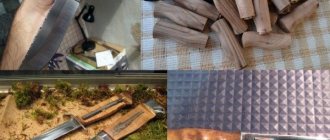The hot knife has become a convenient assistant for needlewomen and craftsmen. They can easily cut any synthetic materials. The edges of the products are smooth, processed, thanks to melting, and without effort, easily touching.
It greatly simplifies the cutting process:
- ribbons,
- felt,
- foamiran,
- plastic,
- expanded polystyrene,
- foam and other synthetic materials.
Hot knives are available in three types:
- stationary, equipped with a housing with a power supply and a tensioned string,
- manual, equipped with knives with blades,
- desktop
The models are similar in principle, but differ in results. Each device has a step-down transformer. However, with a string the material is cut only in a straight line, and with the blade of a hot knife you can make shaped products from fabric and other materials.
Advantages and disadvantages
Thanks to the thermal knife, the creation of multilayer products is greatly simplified.
Its advantages for needlework are obvious:
- No need to use candles or scissors.
- The cuts are obtained without soot.
- High cutting speed increases.
- The ability to neatly join the edges of the material.
- Comfortable to work both sitting and standing.
- Backlight,
- Ruler for cutting cut calculations,
- Uneven temperature conditions in different areas.
Disadvantages include:
- Electricity costs.
- Unpleasant odor from materials such as brocade, organza, plastic, which provokes coughing.
- Lack of quality certificates for many models for home use.
Advantages of plexiglass as a material
Are as follows:
- Glass transmits light well;
- Withstands high mechanical loads;
- There is no hygroscopicity;
- When burning, it does not emit hazardous substances;
- Working with plexiglass is not difficult, even easier than working with wood;
- Plexiglas is not afraid of frost;
- The material is an excellent electrical insulator.
However, organic glass has one serious drawback - it scratches very easily, so it requires careful handling.
How to make a thermal cutter for ribbons with your own hands
To make your own hot knife for cutting satin ribbons you will need:
- a simple transformer with a power of 30-60 watts for halogen lamps,
- insulated wire with a cross section of 1.5 mm,
- a piece of nichrome wire 12-13 cm long,
- bolts, screws, nuts.
6 steps to make a hot knife for cutting satin ribbon
- Convert the transformer to 5-volt voltage using the secondary winding.
- Make a rectangular body from wooden blocks with a fiberglass lid, where to fix the transformer.
- Make holders from galvanized bolts 90 mm high and approximately 6 mm in diameter. Secure them to the body parallel to each other.
- Using a hacksaw, cut 12 mm long holes at the bolts of the holders for fastening the wire, which, after inserting into the slots, is wrapped around the bolts and then clamped with nuts.
- Tension of the wire when heated will occur due to the elasticity of the surface material of the device.
- The front panel is equipped with an on/off toggle switch.
Foam Linear Cutting Cutter
To create a device for horizontally cutting foam sheets, prepare a table. Attach a pair of vertical risers with insulators to it. Stretch a piece of nichrome wire between the risers, the end of which is connected to the contacts of the transformer.
When a hot foam cutting knife is heated, the thread cuts through the foam easily and stays taut with the help of a suspended weight. For vertical cutting, the wire is stretched vertically, and a manufactured frame made of metal or wooden blocks is fixed on the working surface.
Cutter for shaped cutting of foam plastic
Processing large foam sheets with a stationary cutter is difficult, so it is better to use a hand knife for cutting foam. It can easily be made from a jigsaw, replacing the cutting part with nichrome wire.
First, the cutting part of the jigsaw is removed. A wire is connected to the handle. They are isolated. Nichrome wire is connected to the cable using nuts. In addition, you can take a soldering iron and replace the heating element with nichrome wire. Thanks to this device, it is easy not only to cut sheets of foam plastic, but also to make recesses in them.
Metal plate cutter
To modify a soldering iron into a hot knife for foam or synthetic materials with your own hands, you can use a copper or steel plate, carefully sharpened on one side.
It is important that the sharpening angle is small, because the material is cut using both the blade and the plate. This device has one drawback - the optimal temperature is selected experimentally. With such a hot knife it is convenient to cut even plastic.
How to choose cutting wire
A suitable cutter can be made from nichrome wire (X20N80), which is used in the design of most household appliances as a heating element. In terms of mechanical characteristics, nichrome is comparable to ordinary steel, while it has a high resistivity and a heating limit up to temperatures of +1200 ºC. Wire with a diameter of up to 10 mm is available for the manufacture of cutting devices.
Precise and smooth carving of foam plastic is possible by heating the cutting line to a temperature that is two to three times higher than the melting threshold (+270 ºC). It should be borne in mind that such a process involves energy consumption for the absorption of heat by the material itself in proportion to its density. Therefore, for efficient and safe cutting, you need to select a wire of suitable thickness to prevent the metal from melting at maximum heating.
Calculation and preparation of the electrical part
For safe operation of the device, it is necessary to correctly install the current-carrying elements, which are connected to the power source through plug-in terminals. To cut the material, you can use alternating or direct current. The power of the source is calculated based on the fact that to effectively cut 10 mm wire you will need up to 2.5 W (for 500 mm - 125 V).
The current voltage is proportional to the resistance and is calculated using formulas or tables. But on average, with a wire diameter of 0.8 mm, a length of 500 mm and a resistance of 2.2 Ohms, you will need a current source of 12 V with a load current of 12 A. Changing the length up or down will require a similar increase or decrease in voltage at the same force current.
Electricity sources and connection diagram
Safe cutting is ensured by connecting to a regular 220 V household network via a car transformer. To adjust the voltage, a handle is provided in the single primary winding, with which the graphite wheel is moved and the voltage is removed from the corresponding area. This parameter can be changed within the range from 0 to 240 V. Connection to the current source is made through the terminal box.
Read also: Lighting for an aquarium with plants
When connecting a homemade foam cutting machine to the electrical network, you need to make sure that the phase does not fall on the common wire. All necessary parameters and connection diagram can be found on the transformer body. Before connecting to the network, you need to check the functionality of the device using a multimeter.
A simpler option for supplying current to the wire is to use conventional step-down transformers with taps from the secondary windings. In this case , you will not have to select the voltage value , since this value is always constant and sufficient to heat the wire to the desired temperature. You can select the desired value during the initial setup of the transformer by providing a certain number of winding turns in the circuit.
You can also heat the wire for cutting foam using household appliances. The following nuances are taken into account:
- connection via adapters with reliable contact insulation;
- connection of the cutting wire with a conductor not energized (“zero”);
- selecting the power of an electrical appliance based on the expected heating temperature (soldering iron, vacuum cleaner, heater, charging unit with transformers).
It must be taken into account that the cutting tool under voltage will immediately be hot, so you should not touch it to check the temperature.
To make a thermal knife for polystyrene foam or foam rubber, it does not require a significant investment of time and effort. A wire of almost any diameter is suitable for this, but with unknown parameters (diameter, resistance), you need to increase the power gradually, first connecting low-power current sources. Of great importance is reliable insulation of contacts and control of the position of the phase that cannot be connected to the wire.
Have you tried cutting foam with a regular knife? It doesn’t work because the material crumbles. I'll tell you how to make your own foam cutter, and also offer three simple step-by-step instructions for assembling cutters for foam and plastic.
What you need to know about cutting foam
Due to its low cost, polystyrene foam is widely used for insulation. When cutting, due to the low density of the structure, a lot of debris is formed, which becomes electrified and sticks to everything.
To cut foam plastic you can use:
- sharp knives,
- hacksaws for wood or metal,
- soldering irons,
- "Bulgarians"
- thermal cutters,
- machines,
- jigsaws with heated files.
When using non-heating devices, the material will crumble.
Alternative to a jigsaw
For those who do not have the opportunity or desire to use ordinary wood to create a slotted (sawn) wood and use plywood as a material, sawing with a jigsaw is not always the best option. Plywood is a fairly fragile material and can easily break off. And it is often sawed with the formation of untidy “rags” of fibers along the edges of the cut. In addition, for wood, a jigsaw is not always the best tool, especially if you need to process several identical parts.
As an alternative to a regular hand jigsaw, you can use a thin nichrome wire connected to a step-down transformer. In fact, instead of sawing, in this case it turns out to be burning.
Assembling a hand cutter on nichrome thread
To make the device, prepare:
- nichrome wire 0.8-1 mm thick,
- a couple of ice cream sticks,
- a couple of metal strips from a children's construction set,
- bolts and nuts with a diameter equal to the holes in the metal strips,
- block for a pair of AA batteries,
- a couple of AA batteries,
- small button.
- Attach wooden sticks to the battery pack. Apply hot glue to their edges and attach them to the battery pack from the side where the metal terminals are located.
- Drill holes in the strips for the cable. Stepping 5 mm away from the battery pack, drill holes in the wooden sticks with a diameter of no more than 2 mm.
- Pass one wire from the battery pack through both holes to a parallel wooden strip. Pin the button. Cut a piece of wire at a distance of 1 cm from the power supply.
- Solder a button on one side of the wire, and a piece of wire on the other. Glue the button to the bar. Use the same hot glue to insulate the soldering areas.
- Drill holes at the top of the wooden sticks. Bolts are inserted into them to secure the metal strips. Screw the bare ends of the wires from the power supply onto the bolts.
- Thread nichrome wire through the holes of the metal strips. Secure its ends with a screw, nut and washer. Remove excess. Insert batteries into the power supply.
What is nichrome and what is its value?
Nichrome is a special alloy with a high concentration of chromium and nickel. The composition also includes iron, aluminum, silicon, manganese and other chemical elements, the combination of which gives the metal unique characteristics.
Properties of Nickel-Chromium Alloy
The most common nichrome-based alloys are ferronichrome and ferrochromal (fechral). Wire is obtained from them by drawing. The quality of its production is regulated by current state industry standards. GOST 8803-89 and 12766 apply to wire with good electrical resistance. Chrome gives the metal hardness and strength, and nickel gives it ductility. The maximum heating temperature is affected by the percentage of nickel content in the alloy. The more it is, the higher the temperature, which can reach 1000-1300 degrees.
The value of the alloy and products made from it
Products made from an alloy of nickel and chromium have increased resistance to electric current. This means that to obtain the same amount of heat generated, much less nichrome will be needed than other metal. Thanks to this, the weight and dimensions of the devices and devices in which it is used are reduced.
Read also: Types of fluorescent lamp bases
High resistance is ensured by numerous parameters, the main of which is the grade of raw materials used for manufacturing, as well as thickness. The thicker it is, the lower the resistance, which determines the level of heating. The metal does not burn, does not deform, and does not lose its characteristics when exposed to high temperatures.
The useful properties of the alloy include plasticity, which allows you to give the wire the desired shape. The cross-section can be in the form of a circle, oval, square and trapezoid, with a diameter of 0.1 to 1 mm. The value of the alloy is also that, unlike most metals that are susceptible to corrosion, it does not rust, as it has anti-corrosion resistance to aggressive liquid and gaseous media.
Advantages of chromium-nickel alloy products
The main advantages of nichrome wire, thanks to which it has become widespread in many areas of production, are in demand among inventors and home craftsmen:
-hardness, strength and mechanical stability;
-high level of electrical resistivity;
- resistance to aggressive substances.
The only drawback of wire made from an alloy of nickel and chromium is its high cost, which does not in any way affect demand.
Assembling a stationary vertical cutting machine
Using a stationary vertical cutting machine is more convenient than a manual one, because you only need to move the foam sheet. This promotes precision of movements.
To make the device, you need a flat and smooth table surface.
- A block is attached perpendicular to it, and a wooden crossbar is attached to it at a right angle.
- Using an angular ruler, mark the point where the filament will pass, and drill a hole with a diameter of 6 mm into which the wire is threaded.
- The lower end of the string is put on a self-tapping screw, which is screwed in next to the hole.
- A spring is attached to the top screw, and a nichrome thread is attached to it.
Required tools and materials
Polystyrene foam is a lightweight material that can be cut using a variety of tools.
In some cases, the accuracy and cleanliness of the cut is of no small importance. These properties can be achieved using the following tools:
Each builder has his own preferences regarding the choice of one of the tools. All tools allow you to process foam plastic efficiently and form an even line. Foam plastic has low resistance to mechanical stress - this should not be forgotten when choosing a tool.
Step-by-step production of a thermal cutter from improvised materials
For one-time use of a hot knife for cutting plastic or other materials, the purchase is not economically rational.
The most primitive thermal cutter can be made from a guitar string and 5 large flashlight batteries. Connect the batteries into one cell. Connect a string to the ends of this block, creating a closed electric arc that will heat up. When the heated string comes into contact with the surface, the material will melt, breaking into halves with smooth edges. This device can easily handle cutting a sheet of plastic or 2-3 blocks of foam, and then you need to replace the batteries.
Simple electric cutter
When considering how to make a foam cutter, you should study the design of the simplest equipment of this class, which runs on electricity. In this case, you will need to prepare a thin guitar string and several batteries (for example, from a flashlight).
The operating principle of this equipment is simple. The battery structure forms a single unit. A guitar string is connected to it. When electric current passes through the circuit, it will heat up. It is in this state that the string can easily cut a sheet of foam.
When using such a tool, the material will melt. The string heats up to 120 ºС and even more. In this case, it is quite possible to cut several large slabs of foam. If you need to do a large amount of work, this option will not work. The batteries will run out quickly. We will have to provide an option for connecting the system to a household network.



